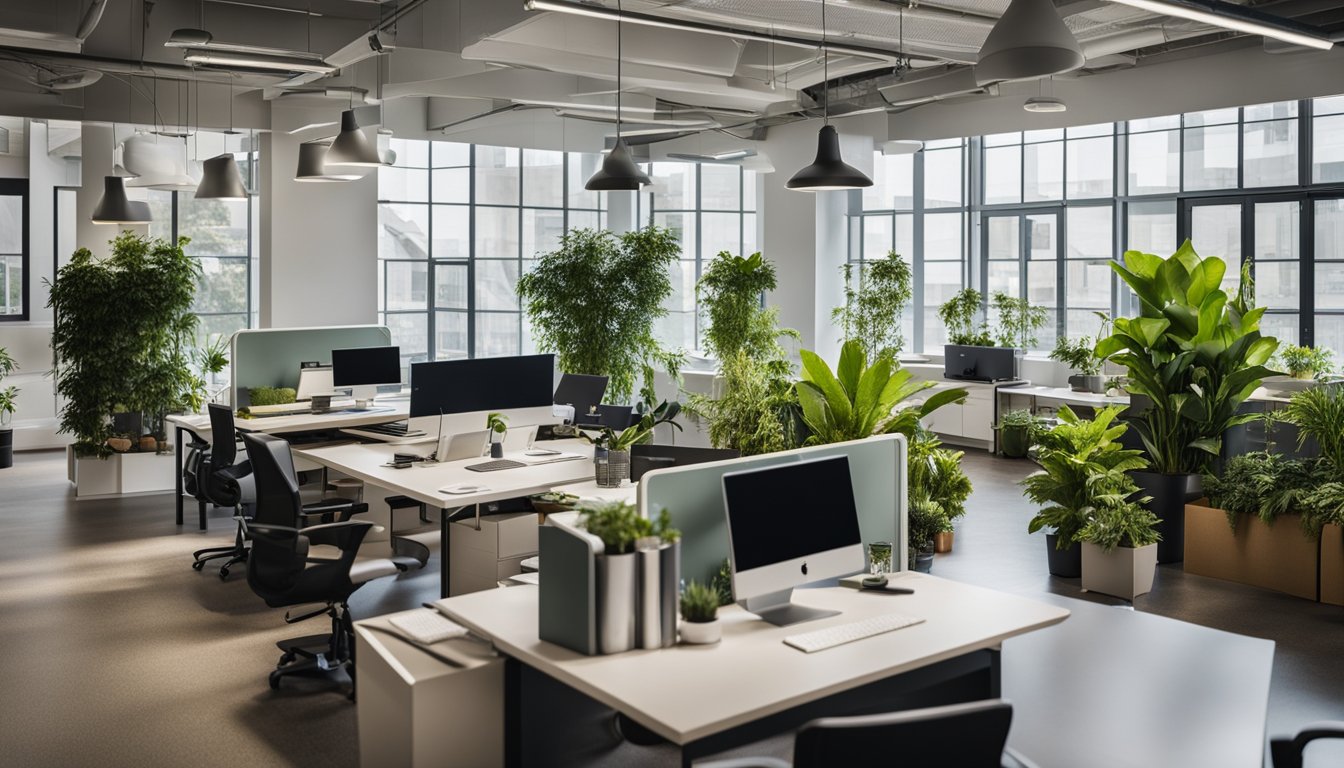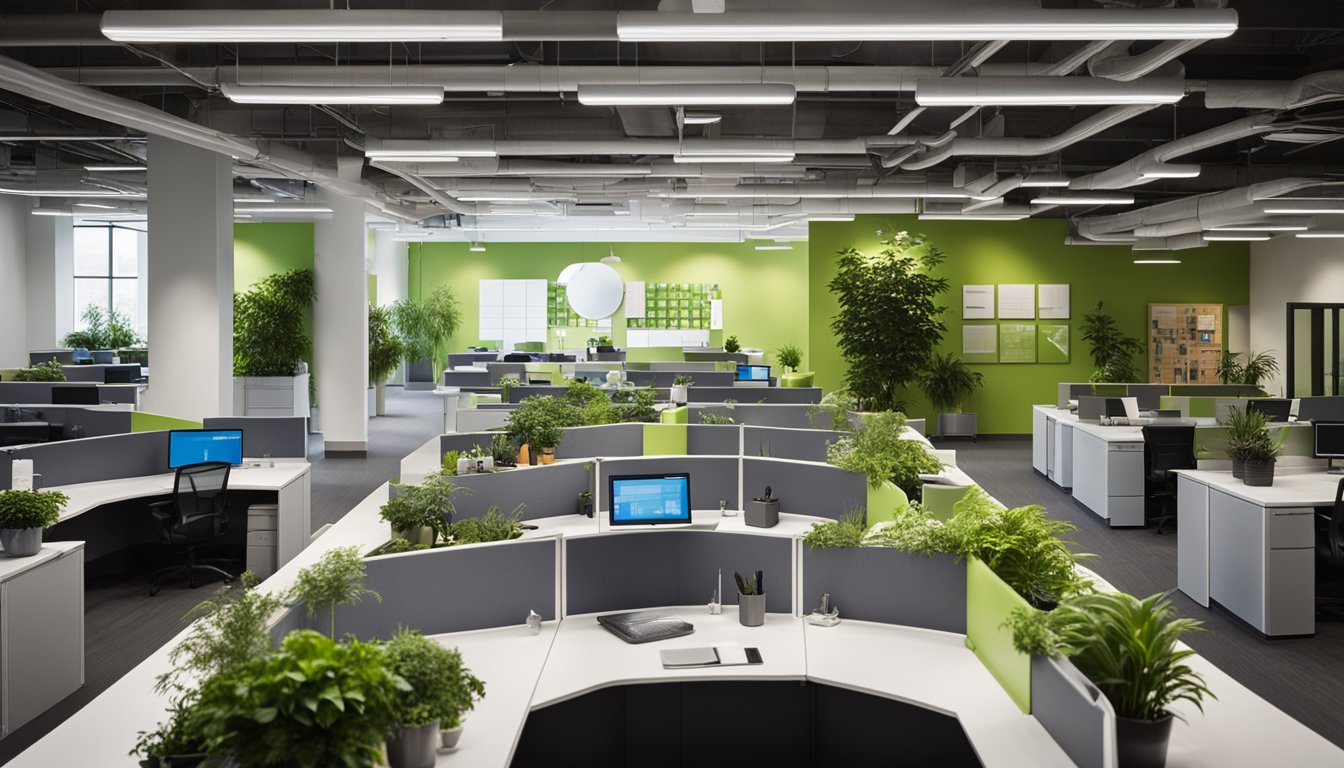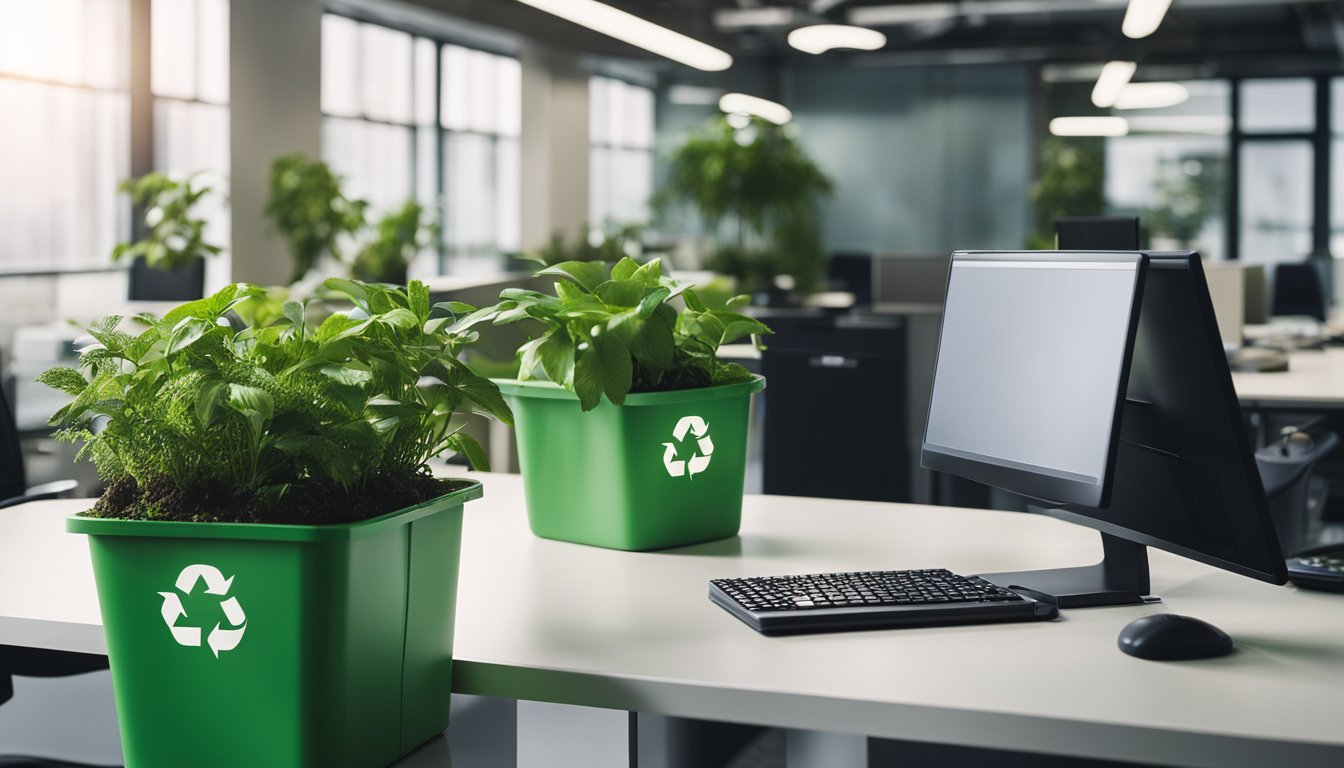Late updated: 12 Aug 2024 10:08
Written by: Amber Collins
Greening Your Business With Sustainable Office Practices: Simple Steps for a Greener Workplace
Sustainability has become a key focus for businesses worldwide, and for a good reason. By adopting sustainable office practices, we can significantly reduce our environmental impact while fostering a healthier and more productive workplace. Integrating eco-friendly strategies into our daily operations contributes to the fight against climate change and can lead to notable cost savings.

Creating a sustainable office doesn’t have to be challenging or expensive. There are numerous straightforward, cost-effective measures we can implement to make a real difference. From choosing green suppliers to encouraging sustainable behaviours among staff, every small step adds up. These efforts not only benefit the planet but also resonate well with clients and employees who value corporate responsibility.
In this article, we will explore actionable ways to transform our office into a greener, more efficient space. We’ll cover practical tips, real-world examples, and answer common questions about building a sustainable workplace. Let's embark on this journey towards a more environmentally conscious business together.
Key Takeaways
- Implementing sustainable office practices reduces environmental impact.
- Cost-effective and simple changes can make a big difference.
- Sustainable practices strengthen our brand and employee morale.
Building a Sustainable Workplace Foundation
To establish a truly sustainable workplace, we must focus on optimising energy use, creating an eco-friendly office environment, and incorporating innovative building designs and materials. These steps can profoundly impact our environmental footprint, and drive significant long-term savings.
Optimising Energy and Utilities
Efficient energy management is critical for a sustainable office space. Conducting an energy audit helps identify areas where we can reduce electricity costs. Switching to LED lighting and installing a smart thermostat optimises heating and cooling systems.
Integrating renewable energy sources, such as solar panels, can further diminish our carbon footprint. Utilising energy-efficient appliances and machinery ensures we minimise unnecessary energy consumption. These efforts collectively contribute to a more sustainable and cost-effective work environment.
Greening the Office Environment
The incorporation of indoor plants enhances indoor air quality, creating a healthier workspace. We should favour natural light to reduce reliance on artificial lighting, employing sustainable design that maximises natural ventilation.
Sustainable furniture, crafted from eco-friendly materials like bamboo or reclaimed wood, should be a staple in our procurement practices. Offering sustainable employee or client gifts also reflects our commitment to environmental responsibility. Establishing a green office environment supports the health and wellbeing of everyone in the workspace.
Innovative Building Design and Materials
Choosing buildings with green infrastructure is essential. Features like green roofs and natural ventilation systems significantly improve energy efficiency. Building with sustainable materials, such as bamboo and reclaimed wood, supports our sustainability efforts.
Installing renewable energy systems both supports our energy needs and reduces our carbon footprint. Embracing these innovative designs ensures our office space is not only functional but also contributes positively to the environment.
By addressing these core areas, we build a robust foundation for a sustainable workplace. This proactive approach not only aligns with our environmental goals but also promotes a culture of sustainability within our organisation.
Cultivating Sustainable Behaviours

Creating a sustainable office begins with embracing eco-friendly practices and fostering a culture that values environmental responsibility. By implementing systems that support sustainable behaviours and encouraging employees to adopt green habits, businesses can significantly reduce their carbon footprint and promote a healthier working environment.
Implementing Office-Wide Sustainable Systems
To make our workspace greener, we need to integrate systemic changes that support sustainability. Smart power strips and motion-activated light switches help to significantly reduce energy waste. Implement a recycling programme with clearly labelled recycling bins for paper, plastics, and e-waste. These simple steps enhance our waste management initiatives.
Adopting digital solutions can help us transition to a paperless office. Utilising recycled paper when printing is unavoidable and choosing green office supplies can further promote sustainability. Moreover, encouraging the use of smart power strips to efficiently manage electronic devices helps in powering down and reducing standby power consumption.
Encouraging Green Commutes and Remote Work
Promoting green transportation options can decrease our collective carbon footprint. We can incentivise cycling or biking by providing secure bike storage and shower facilities. Support for public transport use and carpooling programmes also encourages lower emission commutes.
Remote work options reduce the need for daily travel, leading to fewer cars on the road and reduced office energy use. Additionally, encouraging walking or cycling where possible not only benefits the environment but also enhances employee health, contributing to overall well-being.
Fostering Employee Engagement and Well-Being
For sustainable practices to take root, employee involvement is crucial. We can conduct workshops and training sessions about the benefits of eco-friendly practices and demonstrate ways to incorporate these habits into daily routines. Providing access to green cleaning products and emphasising the importance of reuse and recycling fosters a holistic approach.
Active participation in recycling programmes and initiatives focusing on waste reduction can be encouraged through rewards and recognition. These efforts, aligned with promoting employee health benefits and well-being, embed sustainability into our core values and daily operations. By making sustainability part of our company culture, we drive positive environmental impact together.
Frequently Asked Questions

We address common inquiries on implementing and maintaining sustainable office practices.
How can businesses implement sustainable practices within the office environment?
Businesses can start by conducting an energy audit to identify areas of improvement. Switching to energy-efficient lighting and appliances can make a significant impact. Encouraging the use of digital documents over paper can also reduce waste. Small changes, such as adjusting thermostats and using programmable settings, further enhance sustainability in the office.
What examples of green initiatives can organisations adopt to promote sustainability?
Organizations can promote recycling by providing clearly labelled bins for different materials. They might also consider implementing programmes that encourage walking, cycling, or public transport. Another effective initiative is sourcing office supplies from environmentally-friendly vendors. Encouraging a culture of sustainability through training and awareness campaigns can also foster long-term commitment.
In what ways can a company ensure its office practices maintain environmental sustainability?
Regularly reviewing and updating policies helps maintain environmental goals. Ensuring that sustainability is part of the office culture is key. Companies can set specific objectives, such as reducing water usage or cutting down on single-use plastics. Engaging employees in green practices through incentives or recognition programmes can further support these efforts.
What steps can be taken to foster a healthy and sustainable workplace for employees?
Improving indoor air quality with plants or air purifiers can significantly benefit employee health. Providing ergonomic furniture and promoting regular breaks ensures a comfortable work environment. Companies can also offer wellness programmes that incorporate physical activity and mental health support. Creating bike storage and shower facilities encourages active commuting.
How does environmental sustainability integrate with everyday operations in the workplace?
Sustainability can be integrated into daily operations by prioritising energy conservation, such as powering down equipment when not in use. Using cloud-based servers instead of physical ones can reduce energy consumption. Promote reuse and recycling within the office, including repurposing materials wherever possible. Training staff on efficient resource use and waste management is essential.
What strategies are effective for enhancing a business's commitment to sustainable office practices?
Establishing a green team to spearhead sustainable initiatives ensures ongoing focus. Tracking progress and celebrating milestones keeps everyone motivated. Partnering with like-minded businesses and sharing best practices can provide new ideas and encouragement. Finally, transparent reporting on sustainability efforts builds trust and accountability both internally and externally.
